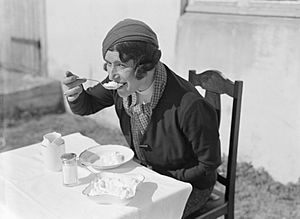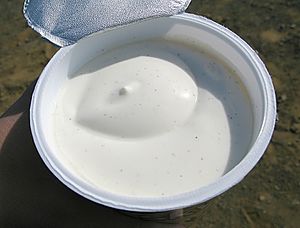Skyr facts for kids
Skyr (pronounced "SKEER") is a special dairy product from Iceland. It started in Norway a long time ago. It looks and feels like a very thick yogurt, but its taste is a bit milder.
You can think of skyr as a type of fresh, soft cheese. It's similar to curd cheese and is often eaten like yogurt in many parts of Europe. Skyr has been an important part of Icelandic cuisine for hundreds of years.
Skyr has a slightly sour taste from the dairy, but it also has a hint of sweetness. People usually eat it cold. You can have it plain or with a bit of cream. Today, companies add different flavors to skyr, like vanilla, coffee, or various fruits.
Contents
The History of Skyr
Skyr has been a main food in Iceland since the time of the Vikings. It is even mentioned in old Icelandic stories from the Middle Ages, like Egil's Saga. Some people believe that skyr was known all over Scandinavia when Iceland was first settled. However, it was eventually forgotten everywhere else except Iceland.
The word "skyr" is related to the English word "shear," which means "to cut." This name comes from how the milk is separated. It splits into a thin liquid called whey and the thick, creamy skyr.
What's in Skyr?
Skyr is a very healthy food! It has a lot of protein and is very low in fat. It's made from milk that has had most of its fat removed. The exact amounts can be a little different between brands.
For example, 100 grams of plain, unflavored skyr usually has about 13 grams of protein. It also has around 4 grams of carbohydrates and only about 0.2 grams of fat. This makes it a great choice for a healthy snack.
How People Use Skyr
People often mix skyr with sugar and milk before eating it. There's a traditional Icelandic dish that mixes skyr with porridge in equal amounts.
Skyr is also great for desserts. You can mix it with jam or fresh fruit. Some people even eat it with prepared fish for dinner, or with cereals for breakfast. Today, skyr is used in many modern ways. It can be a topping for cheesecake or an ingredient in tasty milkshakes and fruit smoothies.
How Skyr is Made
Today, skyr is made from skimmed milk. First, the milk is heated up, usually to about 72–75 degrees Celsius (162–167 degrees Fahrenheit) for a short time. This process is called pasteurizing. Then, the milk is cooled down to about 37 degrees Celsius (99 degrees Fahrenheit).
Next, a small amount of a previous batch of skyr is added to the warm milk. This adds special bacteria that are needed to make skyr. A substance called rennet is also added, which makes the milk start to thicken, or curdle. The mixture is left to ferment for about five hours. After that, it's cooled down to about 18 degrees Celsius (64 degrees Fahrenheit). Finally, the thick skyr is strained through a cloth to remove the liquid whey.
Specific types of bacteria, like Streptococcus thermophilus and Lactobacillus delbrueckii subsp. bulgaricus, are very important in making skyr. These same bacteria are also used to make yogurt. However, a special type of yeast that works at cooler temperatures helps make sure the product becomes skyr and not just yogurt.
Skyr Around the World
Skyr is very popular in Iceland. People started trying to sell it outside of Iceland in 2005. It was first sold in the U.S. at a store called Whole Foods. The next year, companies started making skyr in Denmark and Scotland under a special license.
At first, a big Icelandic dairy company tried to make "skyr" a registered trademark in some countries. But this was later decided to be invalid. The word "skyr" was found to be a general term, just like "milk," so it couldn't be owned by one company.
In the 2010s, skyr became much more popular outside Iceland. It was marketed as a healthy snack because it's low in sugar, has no fat, and is high in protein. In 2012, most of the skyr exported from Iceland went to Finland and the U.S. By 2019, many shops selling only skyr (called "skyr parlors") even opened in Finland!
See also
 In Spanish: Skyr para niños
In Spanish: Skyr para niños




